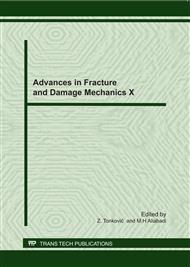p.630
p.634
p.638
p.642
p.646
p.650
p.654
p.658
p.662
Influence of the Wall Thickness on the Allowable and Failure Pressures of Two- and Tree-Way Globe Valve Bodies
Abstract:
A globe valve is a linear motion valve used to shut off and regulate fluid flow in pipelines. Depending on the number of process connections, they are produced as two‑ or three-way valves. The main valve component carrying the internal pressure is the valve body. For safe exploitation, the valves are designed with the allowable internal pressure taken into consideration. The aim of this paper is to investigate the influence of the wall thickness on the allowable and failure pressures of two- and tree-way globe valve bodies, DN50 and DN100 respectively. Twice-elastic-slope (TES) and the tangent‑intersection (TI) methods are used to obtain the plastic collapse pressures at the critical location which was determined (Fig. 1a and 1b) at the location where maximum equivalent plastic strain throughout the valve body thickness reaches the outer surface. Obtained values are used afterwards to calculate corresponding allowable pressures according to the limit design method, while the failure pressure at the same location was determined as the highest point from the load-maximal principal strain curve. Calculated allowable pressure values, for both valve bodies, are compared with the corresponding ones obtained using the EN standard.
Info:
Periodical:
Pages:
646-649
Citation:
Online since:
September 2011
Authors:
Price:
Сopyright:
© 2012 Trans Tech Publications Ltd. All Rights Reserved
Share:
Citation:


